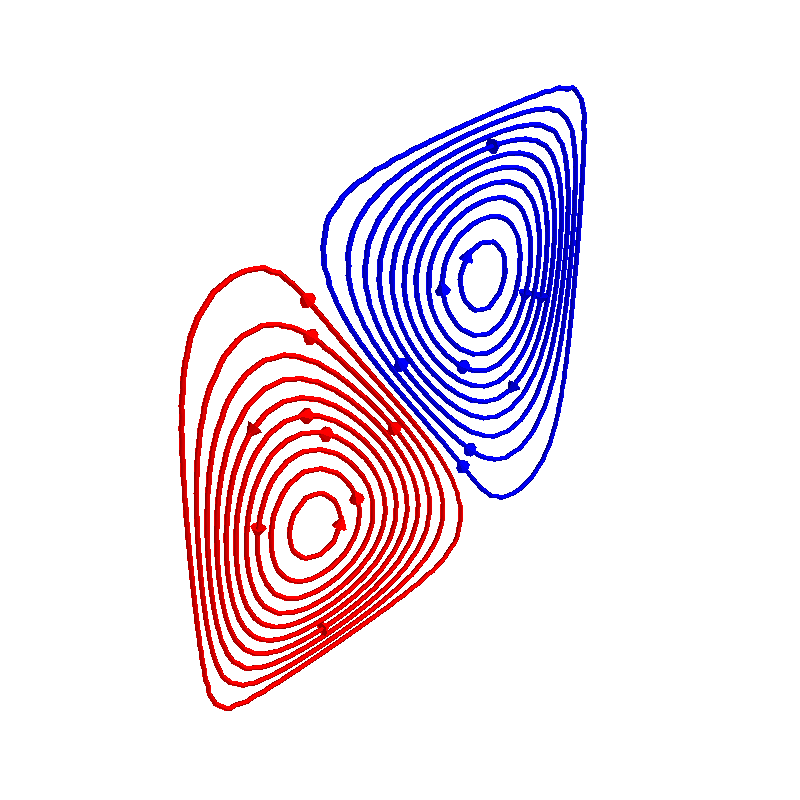Note
Click here to download the full example code
Mutual inductance of wire loops¶
In this example, we demonstrate how to compute the mutual inductance between two sets of polyline wire loops.
from bfieldtools.line_conductor import LineConductor
from bfieldtools.mesh_conductor import StreamFunction
from bfieldtools.suhtools import SuhBasis
from bfieldtools.utils import load_example_mesh
import numpy as np
from mayavi import mlab
We create a set of wire loops by picking a single (arbitrary) surface-harmonic mode from a plane mesh. Finally, we discretize the mode into a set of wire loops, which we plot.
mesh = load_example_mesh("10x10_plane")
mesh.apply_scale(0.1) # Downsize from 10 meters to 1 meter
N_contours = 20
sb = SuhBasis(mesh, 10) # Construct surface-harmonics basis
sf = StreamFunction(
sb.basis[:, 1], sb.mesh_conductor
) # Turn single mode into a stream function
c = LineConductor(
mesh=mesh, scalars=sf, N_contours=N_contours
) # Discretize the stream function into wire loops
# Plot loops for testing
c.plot_loops(origin=np.array([0, -100, 0]))

Out:
Calculating surface harmonics expansion...
Computing the laplacian matrix...
Computing the mass matrix...
<mayavi.core.scene.Scene object at 0x7fc4fa9fba10>
Now, we create a shifted copy of the wire loops, and the calculate the mutual_inductance between two sets of line conductors
mesh2 = mesh.copy()
mesh2.vertices[:, 1] += 1
c2 = LineConductor(mesh=mesh2, scalars=sf, N_contours=N_contours)
fig = c.plot_loops(origin=np.array([0, -100, 0]))
c2.plot_loops(figure=fig, origin=np.array([0, -100, 0]))
Mself = c.line_mutual_inductance(c, separate_loops=True, radius=1e-3)
M2 = c.line_mutual_inductance(c2, separate_loops=True)

Now, we plot the inductance matrices
import matplotlib.pyplot as plt
ff, ax = plt.subplots(1, 2, figsize=(12, 8))
plt.sca(ax[0])
plt.matshow(Mself, fignum=0)
plt.title("Inductance matrix of the first set of wire loops")
plt.sca(ax[1])
plt.matshow(M2, fignum=0)
plt.title("Mutual inductance matrix between the sets of wire loops")
ff.tight_layout()

The inductance derived from the continous current density¶
Magnetic energy of a inductor is E = 0.5*L*I^2
For unit current I=1 the inductance is L=2*E
The total current of a stream function (sf) integrated over the from minimum to maximum is dsf = max(sf) - min(sf)
When discretized to N conductors the current per conductor is I = dsf / N
When sf is normalized such that I=1, i.e., dsf = N the inductance approximated by the continous stream function is L = 2*sf.magnetic_energy
scaling = N_contours / (sf.max() - sf.min())
L_approx = 2 * sf.magnetic_energy * (scaling ** 2)
print("Inductance based on the continuous current density", L_approx)
print("Inductance based on r=1mm wire", np.sum(Mself))
Out:
Computing the inductance matrix...
Computing self-inductance matrix using rough quadrature (degree=2). For higher accuracy, set quad_degree to 4 or more.
Estimating 2432 MiB required for 676 by 676 vertices...
Computing inductance matrix in 20 chunks (3990 MiB memory free), when approx_far=True using more chunks is faster...
Computing triangle-coupling matrix
Inductance matrix computation took 1.31 seconds.
Inductance based on the continuous current density 8.689344781849715e-05
Inductance based on r=1mm wire 9.793656583088348e-05
Total running time of the script: ( 0 minutes 6.240 seconds)
Estimated memory usage: 133 MB
